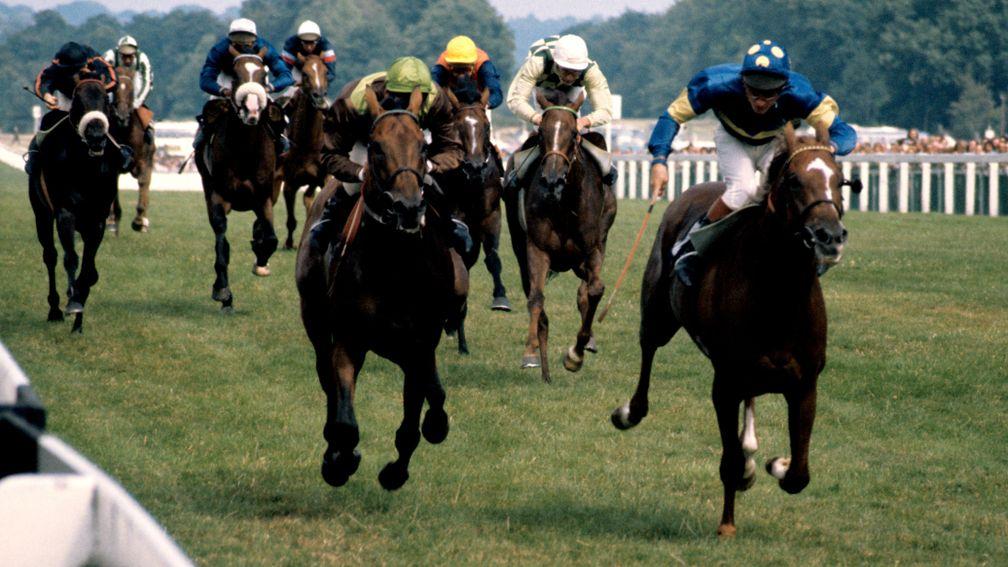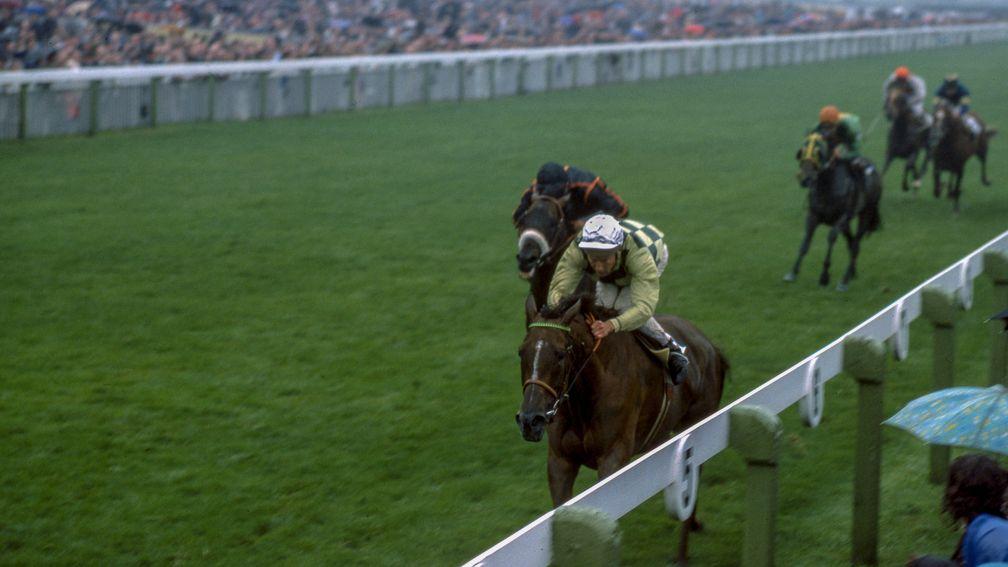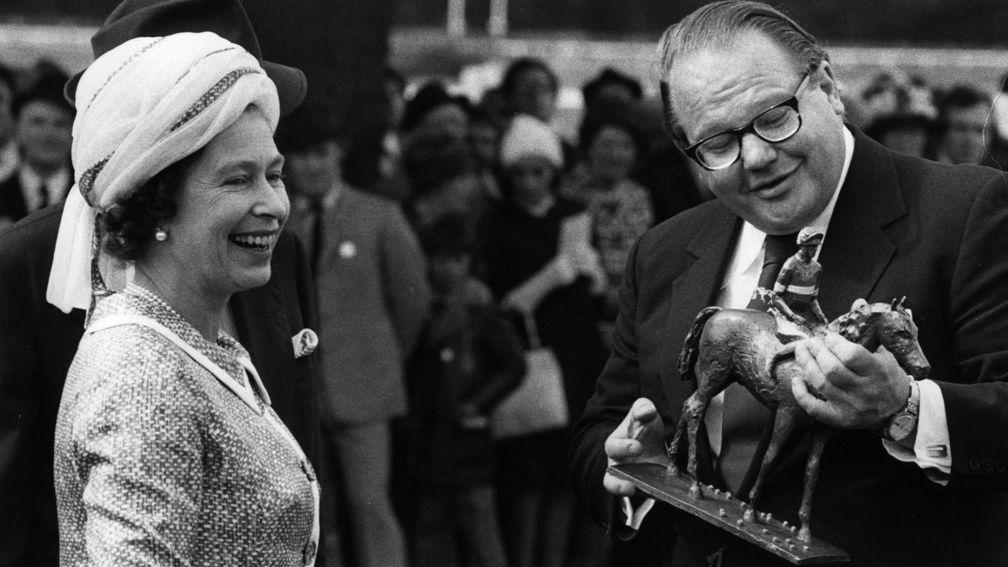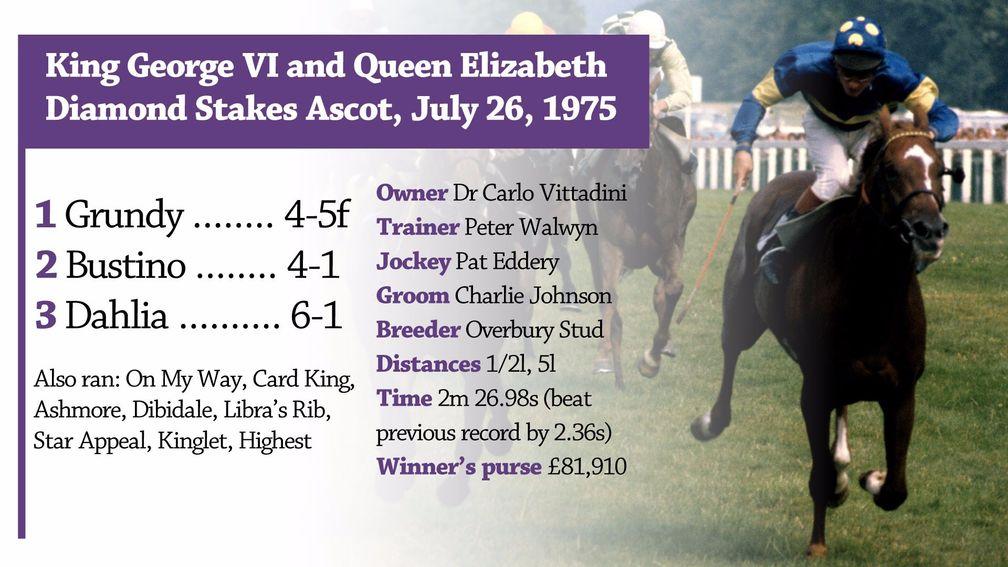From the vaults: Steve Dennis relives the epic battle of Grundy v Bustino

First published on July 20, 2015, Steve Dennis looks back at the race of the century, when Grundy and Bustino went eye to eye down the Ascot straight
Naturally, there has to be a race considered to be ‘the race of the century', but why this one? What elevated this particular race to the general understanding that, in 100 years, there had never been a greater contest between racehorses?
Forty years on, in a new century, we still look to the last 100 years for a frame of reference, for a race by which to weigh the merits of the great contests of a modern era. On a sunny day at Ascot, on rattling fast ground in the richly endowed King George VI and Queen Elizabeth Diamond Stakes, the duel between two brave and brilliant horses left an impression that has survived intact across the decades. Their names? Grundy and Bustino.
The flashy three-year-old star
Grundy was a flashy little chestnut with a white blaze and three white feet, who earned his name through his owner's habitual conflation of the names of sire and dam; Grundy was by Great Nephew out of Word From Lundy, and cost Dr Carlo Vittadini 11,000gns as a Tattersalls yearling. He went into training with Peter Walwyn at Seven Barrows just outside Lambourn, showed early promise at home and soon confirmed it on the racecourse.
As a two-year-old, Grundy – ridden by Pat Eddery throughout his career – won minor events at Ascot and Kempton before advertising his talent on a wider stage by winning the Champagne Stakes at Doncaster. From there he went to Newmarket for the Dewhurst Stakes which, on soft ground, he won very impressively by six lengths from the Middle Park winner Steel Heart.
It was enough to make Grundy champion two-year-old, but he suffered his first defeat on his reappearance at three in the Greenham Stakes at Newbury after his preparation for the race had been hampered by an accident at home a month earlier, when stablemate Corby kicked him hard enough in the face to shatter the bone beneath his eye. But the colt was a hardy type and recovered far more swiftly than either his trainer or vet believed possible.
Beaten into second place by the outsider Bolkonski in the ‘stable lads' 2,000 Guineas, Grundy went on a retrieval mission to the Curragh for the Irish version and, in running out an easy length-and-a-half winner, restored his reputation. His next three races would burnish that reputation to a high shine.
Sent off second favourite for the Derby behind Poule d'Essai des Poulains winner Green Dancer, Grundy stamped his authority on the race and his generation when stretching clear to win by three lengths from the filly Nobiliary. Walwyn then debated the choice between the Eclipse and the Irish Derby and sent Grundy back to the Curragh, where the turn of foot he displayed in coasting to a two-length success confirmed him as a three-year-old of the highest class. Now, at Ascot, he would take on his elders for the first time.
The tough late-maturer
Chief among those elders was Bustino, trained by Dick Hern at West Ilsley and owned by the Dowager Lady Beaverbrook, who bought him for 21,000gns at Tattersalls yearling sales and christened him with the seven-letter name that superstitiously adorned all but a very few of her horses. Bustino was bred on stout and late-maturing lines and ran but once at two, finishing third in the Acomb Stakes at York in the hands of Joe Mercer, who rode him in all his races.
At three he won the Sandown Classic Trial and the Lingfield Derby Trial, on both occasions beating Snow Knight. The Derby was of course the objective, but Bustino was never in a position to challenge and could only stay on strongly for fourth behind 50-1 shocker Snow Knight. Stamina was evidently his long suit and next time out he found only the incomparable stayer Sagaro too good in the Grand Prix de Paris (then run over half a furlong short of two miles).
The St Leger would now be Bustino's primary target and, after an easy win in the Great Voltigeur, he justified his short price in the longest Classic when striding out strongly to win by three lengths, benefiting from the sturdy pace set by his pacemaker Riboson.
It would be a mistake to consider Bustino a one-dimensional stayer, though, and he demonstrated his versatility when breaking the course record in the Coronation Cup on his first run at four. This tall, strong, good-looking bay was reaching his peak and, although Grundy was odds-on at Ascot, Bustino was the deserved second favourite ahead of a strong international field.
There was the magnificent Dahlia, winner of the previous two runnings of the King George as well as the Benson & Hedges Gold Cup and the Washington International. The tough and hugely popular French mare was accompanied by compatriots Ashmore, runner-up in the Coronation Cup, Prix Ganay runner-up Card King, and On My Way. From Germany came Star Appeal, fresh from victory in the Eclipse Stakes and later to win the Prix de l'Arc de Triomphe.
The home contingent was strengthened by the previous year's Irish Oaks and Yorkshire Oaks winner Dibidale, Princess of Wales's Stakes winner Libra's Rib, and two 500-1 no-hopers in Highest and Kinglet, who were acting as pacemakers for Bustino and whose influence on the race of the century was out of all proportion to their abilities.
Major Hern's plan
Hern had formulated a plan to accentuate Bustino's stamina reserves at the expense of Grundy's renowned finishing kick. He would run three pacemakers, who would in effect pass the baton from one to another at the head of affairs and set up the race for Bustino, running the finish out of Grundy. Three pacemakers? Yes –Riboson had been intended to run the ‘anchor leg' at Ascot but a cracked cannonbone on the gallops a couple of weeks earlier ended his career and forced Hern to rethink.
On the day, the miler Highest would be asked to set a fierce gallop, and when he inevitably tired the middle-distance handicapper Kinglet would take over and lead Bustino into the home straight, whereupon he would strike for the line. The absence of Riboson, the ideal ‘lead-out man', would prove crucial.
When the stalls opened, Bustino (one from the rail, in stall ten) was out like a greyhound and led for the first few strides until Frankie Durr, aboard Highest, could get over to the rail from stall one and begin setting the relentless pace that did so much to lift this race on to the highest plane. Durr scrubbed away at Highest's ears as though he was riding a sprinter through the final furlong, and Kinglet – ridden by Eric Eldin – sat in his slipstream. Behind him, in single file, at top speed, came Star Appeal, Bustino, Grundy and Dahlia.
A mile and a half at mile pace
Sectional timing was years in the future so there is no way of discovering the fractions frantically laid down by Highest. Such were his exertions that he could only maintain his lead for five furlongs; hand-timing from YouTube suggests Highest clocked around 58 seconds for that distance.
As Highest dropped away, spent, Kinglet took on the role of domestique and maintained the headlong gallop. Star Appeal was now second, with Bustino and Grundy in line astern. But before long Kinglet too began to show signs of weakening and Mercer, alert to the realities of the unnatural demands being placed upon his outriders, sent Bustino to the front as they passed the half-mile pole. Amateur stopwatch work gives the time for the first mile as 1m 35s; comparisons are practically useless but – for interest's sake – Frankel covered the Guineas mile in 1m 37s.
This, then, was a mile and a half race run at mile pace. Yet Bustino – a St Leger winner – was not only able to match the gallop but also to maintain it. If Riboson had been able to pull him along a little further . . .
Bustino rocketed along towards the home turn, and Eddery – unable to get a vital breather into Grundy – had no option but to send the triple Classic winner in pursuit. Grundy came off the bridle as he passed Star Appeal and Eddery began to shovel on the coal in a bid to reduce the three-length advantage held by Bustino as he flew round the bend into the short straight.
'He kept finding more'
Two furlongs from home, Bustino was two lengths clear of Grundy, with Dahlia and On My Way closer than the rest but never for one moment infringing upon the private duel that was beginning to bring the spectators in the grandstands to their feet. The stylish Mercer rode Bustino with hands and heels, disdaining the whip on a horse who was patently giving his all. The busier Eddery had ground to make up, and he went to the whip. "I thought I'd never get to him," said Eddery afterwards. "Every time I got nearer he kept finding more."

It wasn't until they passed the furlong pole that Grundy finally got within range of Bustino. Dahlia was a distant third, treading water. Eddery thrust the brave little chestnut's head into the lead; it seemed the decisive moment. Yet that calculation did not take into account Bustino's valiant, gallant resistance. As Grundy asserted, Bustino rallied, drawing on who knows what reserves of strength and instinct.
Grundy went a neck up. Bustino fought back, reducing the deficit. Grundy tried to hold him. For a hundred yards the race hung spellbindingly in the balance, the world temporarily reduced to two horses running on muscle memory and willpower. Then Bustino faltered, hung towards the rail, the spirit still willing but the flesh weak, and Grundy ground out a half-length advantage that he sustained to the line. Both horses were practically out on their feet, had given their all.
The course record had been obliterated. The efforts of Highest and Kinglet, and then of Grundy and Bustino, had lowered the previous mark by two and a half seconds; Dahlia, five lengths away in third, also beat the old record. Yet it wasn't purely the evidence of the clock that made this race such a transcendent event.
The time was one thing, the exhilarating tactical nature of the race another, the sheer courage and class shown by the principals a third. It left a permanent mark on the combatants, and an indelible impression on all who witnessed it.
"I was left in front before we turned into the straight, and it was too soon," said Mercer years later. "If we'd had Riboson he'd have taken us right to the line, he was a stayer all right, but it wasn't to be.
"With hindsight I should have sat way back, but he was a galloper, he'd won the Leger, he didn't really have a turn of foot. Grundy came up and looked as though he was going to go by me a furlong out, but my guy stuck his old nut out and wouldn't give in.
"But I knew 100 yards out the game was up. He changed his legs and his tongue lolled out, always a sign you've got to the bottom of a horse. He'd done a tendon and never ran again.
"There's been better horses won the race since, but there's not been better races."
'The effort crucified him'
The passage of time did little to diminish Eddery's recollections either. In an interview with this newspaper, he said: "I was always struggling to lay up, it seemed like Bustino had a little bit more speed than me and when Joe set him alight I thought I wasn't going to catch him.
"But Grundy was so game, had such a big heart, he caught and passed Bustino but I never thought I'd win until the last two strides, we got him and then he came back at us. A few strides after the post Grundy was almost walking, the effort crucified him."
When this newspaper polled its readers about racing's 100 greatest races, the 1975 King George was voted into third place, the highest-ranked Flat race behind only Desert Orchid's Gold Cup and the 1973 Grand National. In the book of the poll, Walwyn recalled: "I was stunned. I suspect most people at Ascot that day felt much the same. Dick was the first to congratulate me. He shook my hand with the grip of a bear. The Queen presented the trophies. It was the perfect day."

The following year, the weight-for-age scale was amended so that four-year-olds in the King George conceded three-year-olds 13lb and not the stone that Bustino gave Grundy. Would the result have been different if Bustino had had a pound less on his back?
It takes two
The 1975 King George defies the usual platitudes about no-one remembering who comes second. After the race, Lady Beaverbrook said of Bustino that "he filled me with pride as well as with heartache", a sentiment that applied universally, and one that has been sustained ever since.
For not only has no-one forgotten the horse who came second, but common consent has accorded him an equal status with the winner. When people talk of the race, and they may talk of this one for another 100 years, it is never Grundy's King George. It is always Grundy-and-Bustino, never one without the other, the half-length that separated them on the track joining them forever together.
To the victor Grundy the spoils, but to both horses the great glory of the 1975 King George, the race of the century, for it takes two to make a horse race. And what a race.

What happened next
In the eyes of most observers, the King George had been such an attritional duel that both horses would be physically diminished by its demands. That proved to be the case.
Grundy had one more race, in the Benson & Hedges Gold Cup at York, in which he was the 4-9 favourite against five rivals, three of whom – Dahlia, Card King and Star Appeal – he had trounced at Ascot. However, when asked for his effort Grundy this time found nothing, having left it all on the field in the King George.
He trailed in more than ten lengths behind all-the-way winner Dahlia, and was retired after he continued to show little lustre in his work before the Champion Stakes. At stud he was a relative success, producing Oaks winner Bireme and Gold Cup winner Little Wolf before being exported to Japan, where he died in 1992.
The King George was Bustino’s last race, the tendon injury he sustained to his off-fore in the closing stages flaring up during his next gallop and prompting his retirement. Grundy was his superior on the track but Bustino was a far more influential stallion – his offspring included Terimon and Paean but his greatest gift to the bloodstock world was the filly Height Of Fashion, dam of Nashwan, Unfuwain and Nayef and grand-dam of Ghanaati. He is also damsire of Vintage Crop.
What writers say about the race of the century
The hardest, most implacable, most moving Flat race that I have ever seen.
Brough Scott, Sunday Times
A glittering, flawless example of horse racing at its most irresistible.
Hugh McIlvanney, The Observer
No race ever was more heroic; no race ever more emotional or exciting. It created an honoured place for Grundy and Bustino in the history of the Turf.
Christopher Hawkins, author of The Race of the Century
The spectators pushing to greet the two heroes know that they have seen as great a race as they are ever likely to witness.
Sean Magee, author of Great Races
Misty-eyed, you ask the question to which you know the answer: 'Wasn't that the greatest race you've ever seen?
Tony Morris, writing in 100 Great Races
Grundy and Bustino would be talked about as long as there were people left on the planet to whom hard battles between horses on high summer grass were matters of importance.
Alastair Down, Racing Post
Published on 8 December 2017inObituaries
Last updated 09:49, 10 December 2017
- Mark Bradstock: the small-scale trainer who defied the odds to win jump racing's ultimate prize
- Grace, charm, style and knowledge - vibrant Maureen Mullins provided the DNA for Irish racing
- An irrepressible character with a ready wit: Alan Sweetman reflects on the life of Tommy Kinane
- Edward Hide: a supreme tactical judge with an unblemished record of integrity and honesty
- Lady O'Reilly: gracious and cosmopolitan host whose love for horses was genuine and rooted in a lifelong passion
- Mark Bradstock: the small-scale trainer who defied the odds to win jump racing's ultimate prize
- Grace, charm, style and knowledge - vibrant Maureen Mullins provided the DNA for Irish racing
- An irrepressible character with a ready wit: Alan Sweetman reflects on the life of Tommy Kinane
- Edward Hide: a supreme tactical judge with an unblemished record of integrity and honesty
- Lady O'Reilly: gracious and cosmopolitan host whose love for horses was genuine and rooted in a lifelong passion